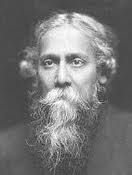 Rabindranath Tagore (1861 – 1941) was a renowned Indian poet, philosopher and artist from Bengal. He became the first non-European Nobel laureate by earning the 1913 Prize in Literature for Gitanjali. Till 1913 he was little known outside of the Calcutta area, and not known at all outside of India. During that period his short stories were published monthly in a friend's magazine and he even played the lead role in a few of the public performances of his plays. In 1912, on the way over to England by Sea,he began translating, for the first time, his latest selections of poems, Gitanjali, into English. Tagore's one friend in England, a famous artist he had met in India, Rothenstein, learned of the translation, and asked to see it. After reading the notebook, the painter could not believe his eyes. The poems were incredible. He called his friend, W.B. Yeats, and finally talked Yeats into looking at the hand scrawled notebook. Yeats was enthralled and rest was history. Less than a year later, in 1913, Rabindranath received the Nobel Prize for literature.
Rabindranath Tagore (1861 – 1941) was a renowned Indian poet, philosopher and artist from Bengal. He became the first non-European Nobel laureate by earning the 1913 Prize in Literature for Gitanjali. Till 1913 he was little known outside of the Calcutta area, and not known at all outside of India. During that period his short stories were published monthly in a friend's magazine and he even played the lead role in a few of the public performances of his plays. In 1912, on the way over to England by Sea,he began translating, for the first time, his latest selections of poems, Gitanjali, into English. Tagore's one friend in England, a famous artist he had met in India, Rothenstein, learned of the translation, and asked to see it. After reading the notebook, the painter could not believe his eyes. The poems were incredible. He called his friend, W.B. Yeats, and finally talked Yeats into looking at the hand scrawled notebook. Yeats was enthralled and rest was history. Less than a year later, in 1913, Rabindranath received the Nobel Prize for literature.
More about Tagore
1. Tagore started writing poetry at the age of 8 under the pseudonym Bhanusimha.
2. He penned two national anthems: the Republic of India's Jana Gana Mana and Bangladesh's Amar Shonar Bangla.
3. Gitanjali (Song Offerings), Gora (Fair-Faced), and Ghare-Baire (The Home and the World) are his best-known works.
4. Visva Bharati University was established by Tagore.
5. In 1915, the British Crown granted Tagore a knighthood. He renounced it after the 1919 Jallianwala Bagh massacre.
6. In 1921, Tagore and agricultural economist Leonard Elmhirst set up the "Institute for Rural Reconstruction", later renamed Shriniketan or "Abode of Welfare".
7. Between 1878 and 1932 Tagore set foot in more than thirty countries on five continents and met Mussolini, Albert Einstein, Robert Frost, Thomas Mann, George Bernard Shaw, H.G. Wells etc
You might also interested in
2. Arya Samaj





0 comments: